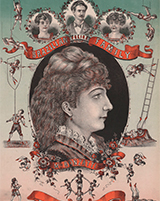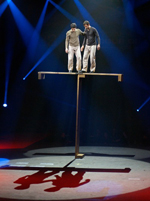by Pascal Jacob
Acrobatics blooms both on and off apparatus, and is a unifying language of the circus arts. The presence or absence of a support, whether as device, constraint or partner, is above all a factor for diversity, creativity and enrichment in the discipline. Apparatus encourages the implementation of a network of forms and techniques based on a shared vocabulary, but it also models another perception of acrobatics by providing as many variations as can possibly be imagined.
Static or mobile, apparatus can be a support providing assurance, or a vector of instability. From balancing canes to the Chinese poles, from free ladder to fixed bars, from perch pole to wooden beam, from balance ball to rola bola, and the chair on glass bottles, it enables the acrobat to compose his own score in harmony or in confrontation with the chosen partner object. Moreover, the use of apparatus is sometimes a determining factor in apprehending the performance space.
By accumulating chairs to "build" a straight or curved column on which to develop balancing acts either individually or as a group, or by creating a new structure by gradually fitting canes together to make long, swaying perch poles used for sequences of dramatic figures, acrobats multiply their means of creating wonder, but they also demonstrate just how far apparatus helps to intensify human performance.
The vertical nature of the Chinese pole, whether a simple bamboo one or one of wood, aluminium or carbon fibre, is an interesting way to create a visual and technical axis at the heart of a theatrical space. It is also an amusing reference to the origins of the practice, linked both to surveillance and fruit picking. The pole, propped up, is an immobile apparatus, but it can also be transformed into a mobile structure if it oscillates or swings.
Lastly, the apparatus is sometimes miniscule: by walking on glasses, the acrobat follows a long tradition that dates back the 19th century and continues today, in a blend of skill, elegance and fragility.







